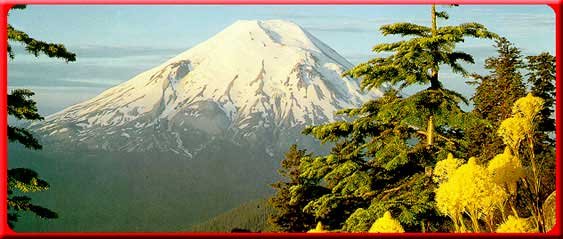
Volcanoes
Hi! Back again with some more info about volcanoes. Last post I talked about stratovolcanoes like the one in the image to the left called Mount Saint Helens. This time we’ll look at shield volcanoes and the most destructive type of volcano, the caldera.
The second type of volcano is like that found in Hawaii. These are called shield volcanoes as they look like an upturned shield. They are broad and flat but can reach enormous size.
 The big island of Hawaii is actually the tallest mountain on Earth if you measure it from its base on the ocean floor. Shield volcanoes build up through the eruption of a series of thin, fluid lava flows. This magma rises up from deeper in the mantle than for stratovolcanoes and they are usually found in the middle of tectonic plates. These volcanoes are the least violent and produce mostly lava. However they erupt often. You could walk fairly close to this type of lava, but be careful not to fall in as it could be as hot as 1200oC.
The big island of Hawaii is actually the tallest mountain on Earth if you measure it from its base on the ocean floor. Shield volcanoes build up through the eruption of a series of thin, fluid lava flows. This magma rises up from deeper in the mantle than for stratovolcanoes and they are usually found in the middle of tectonic plates. These volcanoes are the least violent and produce mostly lava. However they erupt often. You could walk fairly close to this type of lava, but be careful not to fall in as it could be as hot as 1200oC.
The last type of volcano is one that you might not even recognize as a volcano but is the most violent type of all. These are called caldera volcanoes and include Yellowstone in the US, Lake Toba in Indonesia and Taupo in New Zealand. There are some near us in Alaska as well. Luckily these volcanoes do not erupt very often and there has never been an eruption witnessed by people. They explode very violently forming huge clouds of ash, rock and gas that flow across the surrounding countryside. Studies of past eruptions at Taupo show that the flows can climb over tall mountains and bury the countryside in tens of metres of ash over hundreds of kilometers. Everything in their path would be instantly destroyed.

If you want to learn more about volcanoes or check on some of the words that I have used, I suggest that you look at the following web sites:
http://www.geology.sdsu.edu/how_volcanoes_work/
http://volcano.oregonstate.edu
http://volcanoes.usgs.gov
http://www.volcano.si.edu
Teachers, you can use the great information found here:
http://egsc.usgs.gov/isb/pubs/teachers-packets/volcanoes/poster/poster.html
http://egsc.usgs.gov/isb/pubs/teachers-packets/volcanoes/lesson1/lesson1.html
Pictures from the USGS, used with permission.